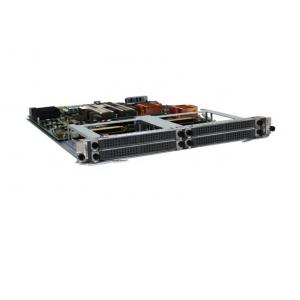| | | | | |
| 50.32 Tbit/s | 25.16 Tbit/s | 12.58 Tbit/s | 7.08 Tbit/s | 1.08 Tbit/s |
| 11,520 Mpps | 5,760 Mpps | 5,760 Mpps | 2,880 Mpps | 360 Mpps |
| 22 slots, including 16 LPUs, 2 SRUs, and 4 SFUs | 12 slots, including 8 LPUs, 2 SRUs, and 2 SFUs | 22 slots, including 16 LPUs, 2 SRUs, and 4 SFUs | 11 slots, including 8 LPUs, 2 SRUs, and 1 SFU | 5 slots, including 3 LPUs and 2 SRUs |
| 1,778 mm x 442 mm x 650 mm (40U) | 934 mm x 442 mm x 650 mm (21U) | 1,420 mm x 442 mm x 650 mm (32U) | 620 mm x 442 mm x 650 mm (14U) | 175 mm x 442 mm x 650 mm (DC 4U);
220 mm x 442 mm x 650 mm (AC 5U) |
Maximum Power Consumption | 7,220W (BSUF-240)
9,040W (BSUF-480) | 4,110W (BSUF-240)
4,770W (BSUF-480) | 4,610W (BSUF-100)
6,210W (BSUF-240) | 2,340W (BSUF-100)
3,220W (BSUF-240) | 920W (BSUF-100) |
Full Configuration Weight | 356 kg | 190 kg | 279 kg | 136 kg | DC: 42 kg (100G)
AC: 52 kg (100G) |
| 100 GE-WAN/LAN
10 GE-WAN/LAN
GE/FE |
| User access protocols: PPPoE, IPoE, 802.1X, and ND access
User authentication protocols: PAP, CHAP, MSCHAP, RADIUS, and
HWTACACS
User billing protocols: RADIUS, HWTACACS, and COPS
User authorization protocols: RADIUS, HWTACACS, and COPS
Policy protocols: COPS, COA |
| Maximum number of sessions supported: 64K per slot and 128K per
device
Maximum number of tunnels supported: 16K per slot, 16K per LAC
device, and 48K per LNS device |
| Supports the static routing protocol and dynamic routing protocols,
such as RIP, OSPF, IS-IS, and BGP-4. All ports support line-rate
forwarding even in complex routing environments, for example, when
route flapping occurs |
| Supports the following:
IPv4/IPv6 dual stacks
A variety of IPv4-to-IPv6 transition technologies: Manually
configured tunnels, IPv6 over IPv4 tunnels, GRE tunnels, IPv4 over
IPv6 tunnels, and IPv6 Provider Edge (6PE)
IPv6 static routes and dynamic routing protocols, such as
BGP4/BGP4+, RIPng, OSPFv3, and IS-ISv6
IPv6 neighbor discovery, PMTU discovery, TCP6, ping IPv6, tracert
IPv6, socket IPv6, static IPv6 DNS, IPv6 DNS server, TFTP IPv6
client, and IPv6 policy-based routing
Network Address Translation IPv6-to-IPv4 (NAT64), NAT44 and
Dual-Stack Lite (DS-Lite)
Internet Control Message Protocol Version 6 (ICMPv6) Management
Information Base (MIB), User Datagram Protocol Version 6 (UDP6)
MIB, TCP6 MIB, and IPv6 MIB |
| Supports the following:
MPLS TE and MPLS/BGP VPN in compliance with RFC 2547bis
Inter-AS Option A, inter-AS Option B, and inter-AS Option C
Integration with Internet services
Martini MPLS L2VPN and Kompella MPLS L2VPN
VPLS and VLL
Heterogeneous interworking
Multicast VPN |
| Supports the following:
Protocols such as IEEE 802.1Q, IEEE 802.1ad, IEEE 802.1D, IEEE
802.1w, and IEEE 802.1s
VLAN aggregation (super VLAN)
Filtering list based on MAC addresses and ports |
| Supports the following:
Protection mechanisms such as IP/LDP/VPN/TE/VLL FRR, IP/TE
automatic rerouting, fast convergence of IGP/BGP/multicast routes,
VRRP, load balancing among IP-Trunk links, BFD, MPLS/Ethernet OAM,
and routing protocol/port/VLAN damping
PW redundancy, E-Trunk, E-APS, and E-STP
In-service patching for smooth software upgrade
Passive backplane
Redundancy backup for key components such as route processing
modules, SFUs, and power modules to guard against a single point of
failure
Switching between components that hot back up each other, Graceful
Restart (GR), NSF, NSR, and ISSU
Hot swapping for all components
Intra- or inter-CGN service chassis 1+1 and 1:1 hot backup |
| Provides a well-designed HQoS mechanism
Provides advanced scheduling and congestion avoidance technologies,
accurate traffic policing and traffic shaping, and complex rule
definition and fine-grained flow identification
Supports MPLS HQoS and ensures QoS for MPLS VPN, VLL, and PWE3
services
Supports DiffServ- and MPLS TE-based DS-TE, eight Class Types
(CTs), and TE-tunnel-based QoS
Supports a maximum of 768K flow queues per slot |
| Supports Destination Address Accounting (DAA), which helps carriers
identify services based on destination network segments and perform
separate accounting for different services on IP bearer networks
Supports Enhanced Dynamic Service Gateway (EDSG), which identifies
various user services based on traffic destination addresses and
implements independent rate limit, accounting, and management for
each service |
| Supports the following:
IGMP v1, IGMP v2, and IGMP v3
Static multicast
Multicast routing protocols, such as PIM-SM, PIM-SSM, MSDP, and
MBGP
Multicast CAC
Interoperability between multicast protocols
Multicast policies for multicast routing protocols and multicast
forwarding
Multicast QoS
Two-level multicast replication on the SFU and LPU to achieve
optimal multicast service performance |
| Supports the following:
ACL-based packet filtering
URPF
GTSM
DHCP snooping
ARP attack defense
DoS attack defense
MAC address limit
MAC-IP binding
SSH
SSHv2 |
| Long-term operating temperature: 0°C to 45°C
Short-term operating temperature: –5°C to 55°C
Long-term operating humidity: 5% to 85%
Short-term operating humidity: 0% to 100%
Operating altitude: Equal to or below 4,000m |


